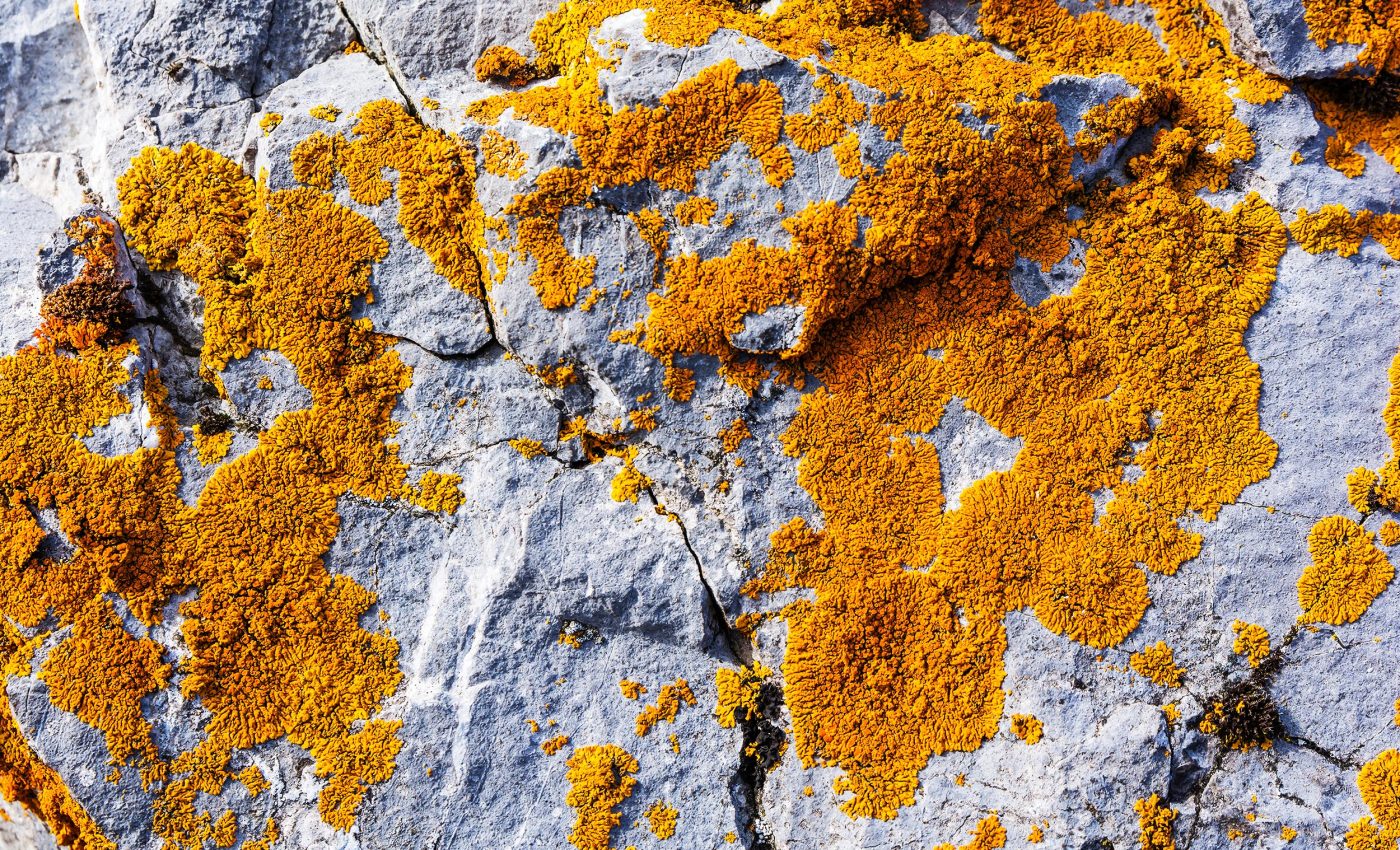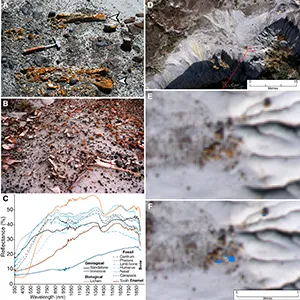
Orange lichens and drones help scientists spot dinosaur fossils
Bright orange lichens are turning out to be unexpected fossil hunters in Alberta’s Badlands. In a new study, scientists discovered that these hardy organisms often grow directly on exposed dinosaur bones.
Their distinctive color signatures can even be detected by drones flying nearly 98 feet above the ground.
The research, conducted in Dinosaur Provincial Park, a UNESCO World Heritage Site in southern Alberta, reveals that orange lichens cover up to half the surface of some fossil bones, while nearby rocks rarely host them.
That striking difference is now helping scientists spot new bonebeds from the air, linking living organisms to traces of life from about 75 million years ago.
How lichens point to fossils
A lichen – a simple partnership of a fungus with algae or cyanobacteria – survives by gluing itself to stable surfaces. It grows slowly, but it can tolerate heat, cold, and long dry spells.
The work was led by Dr. Brian Pickles, an Associate Professor at the University of Reading. His research focuses on symbioses, paleoecology, and field-based sensing.
Orange species such as Rusavskia elegans and Xanthomendoza trachyphylla often thrive on calcareous, calcium-rich, porous surfaces that buffer acidity. Fossil bone offers tiny pores and mineral nutrients that help the lichens persist between rains.
“This pattern of lichen growing preferentially on fossil bone has been noted for decades, but never quantified until now.” said Dr. Caleb Brown, from the Royal Tyrrell Museum of Palaeontology (RTM).
Color clues from the sky
These lichens show distinct spectral patterns that differ from surrounding sediments. The signal lets algorithms sort lichen pixels from look-alike rocks.
The near-infrared light, just beyond visible red, is unusually strong in these lichens. At the same time, their surfaces reflect less blue light than the background.
From about 98 feet up, each sensor pixel was roughly one inch across – enough to flag clusters of orange thalli. An unsupervised classification grouped the pixels by their reflectance patterns and highlighted likely fossil patches.
“This research highlights how modern organisms can help us to find ancient ones.” said Dr. Pickles. He added that this connection between living species and long-extinct animals reveals how ecology and paleontology can work together in unexpected ways.
Old bones, new technology
The pairing of ancient fossils with modern sensors shows how digital tools are reshaping field science. By combining remote-sensing technologies, researchers can find bones that might otherwise stay buried in plain sight.
Drones bridge the gap between on-the-ground surveys and satellite imaging, offering a mid-level scale of detail that suits paleontological work.
This type of approach also points toward the growing use of machine learning – an area of artificial intelligence that helps computers recognize patterns – to classify spectral data faster and with fewer human errors.
With enough training images, algorithms could distinguish between lichen types and highlight the ones most likely linked to bone. Such precision could change how fossil sites are mapped, monitored, and preserved.

Conditions shape detection success
This approach is tuned to semi-arid drylands with sparse plants and long sun exposure. It fits the Canadian Badlands, where wind and water often keep bones exposed for long periods.
The method detects lichens, not bones, so shade, wet crusts, or other orange targets can alter reflectance, the fraction of incoming light a surface returns. Field checks remain essential to confirm each flagged spot before any excavation.
“This drone study lays the groundwork for mapping much larger areas using aircraft and satellites.” said Dr. Derek Peddle, a professor of geography at the University of Lethbridge.
The link between lichen cover and fossil density likely strengthens as bones remain exposed. That trend can vary by bone bed and may weaken in wetter climates where lichens and sediments behave differently.
Lichens and dinosaur fossils
The team proposes a spectral index – a simple ratio of sensor bands – to speed broader searches. With careful calibration, those indices could guide surveys across long reaches of the Badlands.
There is a track record for lichen mapping in wildlife work, including caribou range monitoring. That history suggests satellites can see these targets when conditions are stable and snow-free.
Understanding bone chemistry may also help explain the strong preference for fossil over rock fragments. Bone is largely hydroxyapatite – a calcium phosphate mineral that holds moisture and ions many lichens use.
Scaling beyond a single park will bring practical hurdles that are solvable with good planning. Teams will need sensor settings that avoid glare, standardized flight heights, and seasonal timing that catches lichens at their brightest.
Better prospecting tools can cut field costs and footprints in fragile sites. Fewer random hikes mean less erosion and more time spent where fossils actually sit.
The work also connects modern ecology with deep time in a direct way. Living lichens are growing on bones from animals that died about 75 million years ago.
The study is published in Current Biology.
—–
Like what you read? Subscribe to our newsletter for engaging articles, exclusive content, and the latest updates.
Check us out on EarthSnap, a free app brought to you by Eric Ralls and Earth.com.
—–













